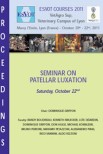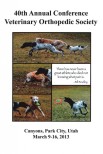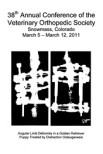OBJECTIVE:
To determine whether there is a difference between the ability of peak vertical force (PVF), vertical impulse (VI), and percentage body weight distribution (%BW(dist) ) in differentiating which leg is most affected by hip joint pain before total hip replacement (THR) surgery, and for measuring changes in limb use after THR surgery.
STUDY DESIGN:
Prospective clinical study.
ANIMALS:
Dogs (n = 47).
METHODS:
Ground reaction force (GRF) data were collected using a pressure-sensitive walkway the day before THR surgery and at ∼3, 6, and 12 months postoperatively. PVF and VI expressed as a percentage of body weight (%PVF, %VI), and %BW(dist) were recorded. Regression models performed separately for each outcome were used for statistical analysis.
RESULTS:
When comparing limb use between the affected limb (AP) and the nonaffected limb (NP) preoperatively, differences between limbs were statistically significant when evaluated using PVF (P = .023), VI (P = .010), and %BW(dist) (P = .012). When evaluating the magnitude of absolute and percentage change difference in AP limb use preoperatively versus postoperatively, differences were statistically significant when evaluated using PVF (P < .001 and P = .001, respectively), VI (P = .001 and P < .001) and %BW(dist) (P < .001 and P < .001).
CONCLUSION:
There appeared to be no difference in the sensitivity of VI, PVF, and %BW(dist) for evaluating limb use before and after THR.
Comparison of body weight distribution, peak vertical force, and vertical impulse as measures of hip joint pain and efficacy of total hip replacement.
Date
2012 May
Journal
Vet Surg
Volume
41
Number
4
Pages
443-7









